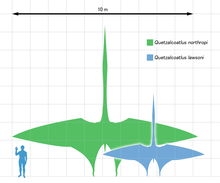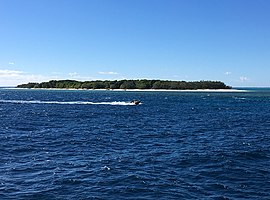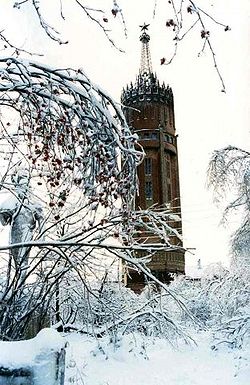익룡 크기
Pterosaur size익룡은 지금까지 살았던 것 중 가장 큰 날짐승을 포함했다. 그것들은 공룡과 밀접한 관련이 있는 선사시대의 대공룡 파충류 종이다. 익룡들 중 종은 수생에서 숲에 이르기까지 여러 종류의 환경을 점유했다. 아래는 2016년[update] 현재 알려진 가장 큰 익룡으로 구성된 목록이다.
가장 작은 것으로 알려진 익룡은 날개 길이가 약 25cm(10인치)인 네미콜롭테루스다.[1] 그러나 발견된 표본은 청소년 또는 아성체일 수 있으며, 성인은 더 컸을 수 있다.
날개 폭이 가장 큰 익룡
이것은 익룡의 목록으로, 최대 날개 폭이 5미터(16피트) 이상일 것으로 추정된다.
- 아람부르시아 필라델피아 7–13m(23–43ft)[2][3]
- 해체고프테릭스 삼베마 11-12m(36~39ft)[4]
- 퀘살코틀러스 노토피10–11m(33–36ft)[4][5]
- 크라이오드라콘 보레아스 10m(33ft)[citation needed]
- 몽골에서 추출한 샘플 10m(33ft)[6][7]
- 원치 않는 시료 UNCUYO-LD 350 9.1m(30ft)[8]
- Tropeognathus mesembrinus 8.2m(27ft)[9]
- Geostenbergia maysay 7.25 m(24피트)[10]
- 콜로보린쿠스 카피토 7m(23ft)[11]
- 모가노프테루스 주아나 7m(23ft)[12]
- 타푼가카 샤위 7m(23ft)[13]
- 프테라노돈 긴두근 6.25m(20.5ft)[10]
- 투푸수아 롱기리스타투스 6m(20ft)[14]
- 산타나닥틸루스 아라리펜시스 5.7m(19ft)[15]
- 세라닥틸루스 atrox 5.5m(18ft)[15]
- 코크케팔루스 트리미크로돈 5m(16ft)[16]
- Istiodactylus latidens 5m(16ft)[15]
- 라쿠소바거스는 5m(16ft)[17]의 장엄함을 자랑한다.
- 랴오닝옵테루스 구이 5m(16ft)[citation needed]
- 포스파토드라코 모리타니쿠스 5m(16ft)
- 안한구에라 sp. 4.5m(15ft)[18]
익룡의 크기와 비행에 대한 추측
익룡의 몇몇 종은 매우 큰 크기로 성장했고 이것은 비행능력에 영향을 미친다. 익룡은 작지만 가장 큰 익룡은 날개 길이가 9m(30ft)를 넘었다. 이 중 가장 큰 것은 무게가 250kg(550lb)인 것으로 추정된다. 이에 비해 방황하는 알바트로스는 최대 3.5m(11ft)로 살아있는 새의 날개 폭이 가장 크지만 보통 무게가 12kg(26lb)도 안 된다. 이것은 가장 큰 익룡이 (날개 프로필에 따라) 현대 조류보다 날개 하중이 더 높았을 수 있다는 것을 나타내며, 이는 익룡 비행이 현대의 조류 비행과 다를 수 있는 방식에 영향을 미친다.
중생대의 더 따뜻한 기후나 더 높은 수준의 대기 산소와 같은 요소들이 제안되었지만, 현재 일반적으로는 가장 큰 익룡들도 오늘날 하늘을 날 수 있었다는 것에 동의하고 있다.[19] 부분적으로, 이것은 날개막에 공기 주머니가 있고,[20] 익룡이 현대 박쥐와 비슷한 4중으로 앞다리를 이용하여 비행하기 때문인데, 이것은 현대의 두발로 발사되는 것보다 빠르고 에너지 세금을 적게 부과하는 방법이다.[21][22]
참고 항목
참조
- ^ Wang, X.; Kellner, A.W.A.; Zhou, Z.; Campos, D.A. (2008). "Discovery of a rare arboreal forest-dwelling flying reptile (Pterosauria, Pterodactyloidea) from China". Proceedings of the National Academy of Sciences. 105 (6): 1983–1987. Bibcode:2008PNAS..105.1983W. doi:10.1073/pnas.0707728105. PMC 2538868. PMID 18268340.
- ^ Frey, E.; Martill, D.M. (1996). "A reappraisal of Arambourgiania (Pterosauria, Pterodactyloidea): One of the world's largest flying animals". Neues Jahrbuch für Geologie und Paläontologie - Abhandlungen. 199 (2): 221–247. doi:10.1127/njgpa/199/1996/221.
- ^ 페레다 수베르비올라, X, 바르데, N, 조브, S, 이아로첸, M, 부야, B., 아마라타자즈, M. (2003) "모로코의 후기 백악기 인산염에서 나온 새로운 아즈다르키드 익룡." 인: 부페라우트, E.와 마진, J.M. (에드), 익룡의 진화론과 팔래생물학. 런던지질학회, 특별출판, 217. 페이지 87
- ^ a b Witton, Mark P.; Martill, David M.; Loveridge, Robert F. (2010). "Clipping the Wings of Giant Pterosaurs: Comments on Wingspan Estimations and Diversity". Acta Geoscientica Sinica. 31 (Supp 1): 79–81.
- ^ Witton, M.P.; Naish, D. (2008). "A Reappraisal of Azhdarchid Pterosaur Functional Morphology and Paleoecology". PLOS ONE. 3 (5): e2271. Bibcode:2008PLoSO...3.2271W. doi:10.1371/journal.pone.0002271. PMC 2386974. PMID 18509539.
- ^ 츠이지, T, B. 안드레스, P. M. 오코너, M. 와타베, K. Tsogtbaatar, 그리고 B. 메인바야르(2017). 거대한 익룡은 몽골의 백악기 상부에 남아 있다. 척추동물 고생물학 저널. doi: 10.1080/02724634.2017.201431.
- ^ "Ancient Winged Terror Was One of the Largest Animals to Fly". 2017-10-31.
- ^ 레오나르도 D. 오르티스 데이비드, 베르나르도 J. 곤살레스 리가 & 알렉산더 W. A. 켈너(2017년). 남아메리카에서 가장 큰 익룡 발견 백악기 연구(https://doi.org/10.1016/j.cretres.2017.10.004; doi: https://doi.org/10.1016/j.cretres.2017.10.004
- ^ Kellner, A. W. A.; Campos, D. A.; Sayão, J. M.; Saraiva, A. N. A. F.; Rodrigues, T.; Oliveira, G.; Cruz, L. A.; Costa, F. R.; Silva, H. P.; Ferreira, J. S. (2013). "The largest flying reptile from Gondwana: A new specimen of Tropeognathus cf. T. Mesembrinus Wellnhofer, 1987 (Pterodactyloidea, Anhangueridae) and other large pterosaurs from the Romualdo Formation, Lower Cretaceous, Brazil". Anais da Academia Brasileira de Ciências. 85 (1): 113–135. doi:10.1590/S0001-37652013000100009. PMID 23538956.
- ^ a b Benton, S.C. (1994). "The Pterosaurs of the Niobrara Chalk". The Earth Scientist. 11 (1): 22–25.
- ^ Martill, D.M.; Unwin, D.M. (2011). "The world's largest toothed pterosaur, NHMUK R481, an incomplete rostrum of Coloborhynchus capito (Seeley 1870) from the Cambridge Greensand of England". Cretaceous Research. 34: 1–9. doi:10.1016/j.cretres.2011.09.003.
- ^ Lü Junchang; Pu Hanyong; Xu Li; Wu Yanhua; Wei Xuefang (2012). "Largest Toothed Pterosaur Skull from the Early Cretaceous Yixian Formation of Western Liaoning, China, with Comments On the Family Boreopteridae". Acta Geologica Sinica. 86 (2): 287–293. doi:10.1111/j.1755-6724.2012.00658.x.
- ^ Timothy M. Richards; Paul E. Stumkat; Steven W. Salisbury (2021). "A new species of crested pterosaur (Pterodactyloidea, Anhangueridae) from the Lower Cretaceous (upper Albian) of Richmond, North West Queensland, Australia". Journal of Vertebrate Paleontology: e1946068. doi:10.1080/02724634.2021.1946068.
- ^ Unwin, David M. (2006). The Pterosaurs: From Deep Time. New York: Pi Press. p. 246. ISBN 0-13-146308-X.
- ^ a b c 웰호퍼, P.(1991) 익룡 백과사전. 뉴욕: 반즈와 노블 북스 124쪽 ISBN 0-7607-0154-7
- ^ Steel, L.; Martill, D.M.; Unwin, D.M.; Winch, J. D. (2005). "A new pterodactyloid pterosaur from the Wessex Formation (Lower Cretaceous) of the Isle of Wight, England". Cretaceous Research. 26 (4): 686–698. doi:10.1016/j.cretres.2005.03.005.
- ^ Witton, M.P. (2008). "A new azhdarchoid pterosaur from the Crato Formation (Lower Cretaceous, Aptian?) of Brazil". Palaeontology. 51 (6): 1289–1300. doi:10.1111/j.1475-4983.2008.00811.x.
- ^ Aureliano, T.; Ghilardi, A.; Duque, R.; Barreto, A. (2014). "On the Occurrence of Pterosauria in Exu, Pernambuco (Lower Cretaceous Romualdo Formation, Araripe Basin), Northeastern Brazil". Estudos Geológicos. 24 (2): 15–27. doi:10.18190/1980-8208/estudosgeologicos.v24n2p15-27.
- ^ 위튼, 마크 P(2013). 익룡: 자연사, 진화, 해부학. 프린스턴 대학 출판부. ISBN 0691150613.
- ^ Claessens, Leon P. A. M.; O'Connor, Patrick M.; Unwin, David M. (February 18, 2009). "Respiratory Evolution Facilitated the Origin of Pterosaur Flight and Aerial Gigantism". PLOS ONE. 4 (3): e4497. Bibcode:2009PLoSO...4.4497C. doi:10.1371/journal.pone.0004497. PMC 2637988. PMID 19223979.
- ^ Fox, Stuart (May 1, 2009). "How Giant Pterosaurs Took Flight". Scientific American. Retrieved July 11, 2014.
- ^ 위튼, 마크 P(2013). 익룡: 자연사, 진화, 해부학. 프린스턴 대학 출판부. ISBN 0691150613.



